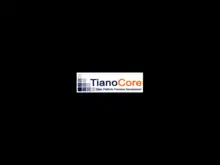TianoCore EDK II
TianoCore EDK II (formerly Tiano) is the reference implementation of UEFI by Intel. EDK is the abbreviation for EFI Development Kit and is developed by the TianoCore community.[1] TianoCore EDK II is the de facto standard generic UEFI services implementation.[2]
 TianoCore EDK II splash screen | |
| Developer(s) | Intel |
|---|---|
| License | BSD-2-Clause-Patent |
| Website | github |
History
In 2004, Intel released their "Foundation Code" of their EFI implementation using a free license. This later evolved into EDK and EDK II, within the TianoCore community.[1] EDK II was released in 2010 under the package known as "UEFI Development Kit" (UDK2010).[3]
Although EDK II implements the UEFI specification, it is not endorsed by the UEFI Forum.[1]
Projects

EDK II code has been integrated into other projects.
A part of TianoCore is the UEFI shell. When a specific UEFI vendor does not support an UEFI shell feature, the UEFI shell from TianoCore can be used.[4]
Project Mu
Project Mu is a fork of EDK-II by Microsoft.[7][8] It is an open source release of the UEFI core used in Microsoft Surface and Hyper-V products initiated by Microsoft in December 2018.[9] The project promotes the idea of Firmware as a Service.[10] The project was started to replace TianoCore's edk2 implementation to improve quality tests of the competing open source UEFI core.[11]
EFIDroid
EFIDroid is a bootloader for Android devices based on Snapdragon processors that is based on EDK-II.[12]
References
- "What is TianoCore?". www.tianocore.org. Retrieved 2021-03-26.
- Häuser, Marvin; Cheptsov, Vitaly (2020). "Securing the EDK II Image Loader". 2020 Ivannikov Ispras Open Conference (ISPRAS). pp. 16–25. arXiv:2012.05471. doi:10.1109/ISPRAS51486.2020.00010. ISBN 978-1-6654-1291-9. S2CID 228084173.
- Barry, Peter (2012). Modern embedded computing : designing connected, pervasive, media-rich systems. Patrick Crowley. Amsterdam: Elsevier/Morgan Kaufmann. p. 173. ISBN 978-0-12-394407-8. OCLC 778434967.
- Babar, Yogesh (2020). Hands-on booting learn the boot process of Linux, Windows, and Unix. Berkeley, CA: Apress L. P. p. 119. ISBN 978-1-4842-5890-3. OCLC 1164505064.
- "Google Pushes "Project PIANO" Into Coreboot - Phoronix". www.phoronix.com. Retrieved 2021-03-26.
- "Coreboot Now Has Basic UEFI Support Working With TianoCore - Phoronix". www.phoronix.com. Retrieved 2021-03-26.
- "Microsoft releases Mu open-source UEFI firmware | bit-tech.net". Bit-tech. Retrieved 2021-03-26.
{{cite web}}: CS1 maint: url-status (link) - "Microsoft Announces "Project Mu" For Open-Source UEFI Alternative To TianoCore - Phoronix". www.phoronix.com. Retrieved 2021-03-26.
- Microsoft Announces "Project Mu" For Open-Source UEFI Alternative To TianoCore - Phoronix
- "Microsoft announces Project Mu, an open-source release of the UEFI core". 20 December 2018.
- "Microsoft announces Project Mu to promote Firmware as a Service".
- "EFIDroid: A Second-Stage Bootloader Using UEFI Firmware to Multiboot [XDA Spotlight]". xda-developers. 2017-03-06. Retrieved 2021-03-26.